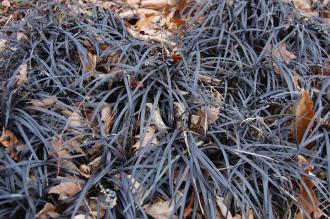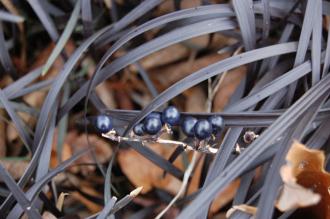
Ophiopogon planiscapus 'Nigrescens' (21/01/2012, Kew, London)
Position: Full sun to partial shade
Flowering period: Early summer
Soil: Moist, well drained
Eventual Height: 20cm
Eventual Spread: 15cm
Hardiness: 6a – 10b
Family: Asparagaceae
Ophiopogon planiscapus ‘Nigrescens’ is a low growing, spreading, evergreen perennial. Its leaves are nearly black in colour, strap shaped and arching and up to 30cm long. The leaves will be greener if grown in shady conditions. The flowers of the plant are short, bell shaped and pale purple to white in color. The fruit of the plant is round, fleshy, dark blue to black in color and up to 5mm across. This plant spreads by its rhizomatous roots.
Ophiopogon planiscapus ‘Nigrescens’, commonly known as Lilyturf or Black Mondo Grass, is native to Korea and Japan, where it grows on open and forested slopes.
The etymological root of the binomial name Ophiopogon is derived from the Greek ofio ‘serpent’ and pwgwn ‘beard’. Planiscapus is derived from the Latin planus ‘flat’ and scapus ‘stem’. Nigrescens is derived from the Latin nigresco ‘becoming black’

Ophiopogon planiscapus 'Nigrescens' berries (21/01/2012, Kew, London)
The landscape architect may find Ophiopogon planiscapus ‘Nigrescens’ useful as a low growing, spreading ground cover plant. Its dark foliage and strap like leaves may be used playfully with other contrasting foliage plants.
Ecologically O. planiscapus ‘Nigrescens’ is attractive to slugs, snails, bees and butterflies.
The Royal Horticultural Society has given O. planiscapus ‘Nigrescens’ their prestigious Award of Garden Merit in 1993.
O. planiscapus ‘Nigrescens’ prefers moist, fertile, well-drained soils. It tolerates most pH of soil, although it prefers slightly acidic soils.
O. planiscapus ‘Nigrescens’ requires little maintenance. Large clumps of this plant may be divided in spring.
Advertisement
